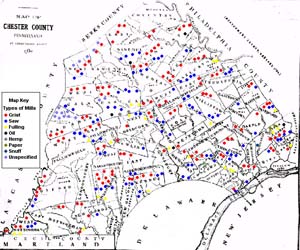
Colonial Pennsylvania Mills
Because of the social and economic structure of early America, colonial mills functioned far differently than in Europe.
First, food was far more plentiful and varied. Except during the early
periods when colonies were originally settled, and occasionally, in
cities only, when large military expeditions took a great deal of food,
food shortages were unknown. Colonists had plenty of meat – pigs ran
wild, almost anyone could hunt, chickens and rabbits were cheap – and
grew almost every vegetable that we do on the same soil today. Most
colonists (some 95%) lived in farming communities and food was
plentiful. Hence, bread was a much less important part of the diet than
in Europe. There was an assize of bread, but it died out shortly after
the Revolution, was enforced only in cities (where a large number of
people did not bake their own bread) and then only rarely because
competition among bakers kept prices down.
 Second, because there was no manorial system, except in New York, mills
could (and were) built almost anywhere. Pennsylvania had nearly 2000 in
1800, and an examination of statistics from 1770 indicates that,
depending on the location, there was one mill per every 21-78 households.
Newly settled areas had fewer mills because they needed time to catch
up. As the map of Chester County shows (click image to see larger view), within a county that extended
about twenty by thirty miles, there were about 200 mills. Because of the
abundance of streams and rivers, windmills were unnecessary. The map
shows a concentration of mills along the major streams, but those
townships which had them also had streams that simply don’t appear on
the map.
Second, because there was no manorial system, except in New York, mills
could (and were) built almost anywhere. Pennsylvania had nearly 2000 in
1800, and an examination of statistics from 1770 indicates that,
depending on the location, there was one mill per every 21-78 households.
Newly settled areas had fewer mills because they needed time to catch
up. As the map of Chester County shows (click image to see larger view), within a county that extended
about twenty by thirty miles, there were about 200 mills. Because of the
abundance of streams and rivers, windmills were unnecessary. The map
shows a concentration of mills along the major streams, but those
townships which had them also had streams that simply don’t appear on
the map.
Third, government authority was weak (there was usually no army except
the militia, that is, the citizens themselves) and responsive to popular
will. People set up mills generally when and where they wanted. Millers
would only be subject to litigation if they deprived downstream folk of
water via dams, or (like almost everyone in early America) were involved
in the actions for debt that constituted almost all the business of
early American county and colony-wide courts. (Offenses against public
order short of grand larceny, counterfeiting, serious assault, and
murder were usually handled summarily by justices of the peace.) In
Pennsylvania, many people baked their bread at home from whatever they
preferred (corn, pumpkin, wheat). Grain mills were primarily used for
flour intended for export – farmers would grow wheat, which was shipped
mostly to the slave colonies of the West Indies, where plantation owners
found it more profitable to import food from abroad than to give up the
scarce lands where sugar – which was to the 16-19th centuries what oil
is to the twentieth – could be grown. Individual farmers could choose to
participate in the market to the extent they wished to work and obtain
commodities (via the merchants) from abroad. The miller usually took a
percentage of the flour as his price.
Trouble with millers and flour seems to have occurred only in the 1780s,
when the newly arrived “Hessian fly” – blame it on the enemy* — proved
devastating to the white clean wheat that was usually grown and
preferred for export (easier to clean) but yellow bearded wheat proved
resistant. (There was also a red wheat.) Some farmers and millers
adulterated their yellow wheat, but this seems only to have reached the
level of complaint, not of legislation or litigation.
If a miller cheated, his nearby competition could beat him out. Unlike
in Europe, there were no monopolies on mills. People did not require
bread for survival in a varied diet, and only after the Revolution (c.
1800) did the contemporary taste for the white (wheat) bread preferred
by the elite begin to make headway. Greedy millers were not subjects of
sarcastic humor in colonial publications as were greedy lawyers,
incompetent physicians, and corrupt politicians; rather, many were social
and political leaders.
Only the lawyers, merchants and farmers outranked the millers in numbers.
For work on early mills in a given area, old town and county histories
(many written around the turn of the 19-20th century) are invaluable; so
is the list maintained by the Society for the Preservation of Old Mills.
Locations can be scouted out – in certain places, like Centre County,
they are easy to find because places are called Spring Mills, Pine Grove
Mills, etc. If not, find the first settlement and the river or stream on
which it took place, and you’ll find where the earliest mills were.
Return to:
One-Minute Essays
 |
|

|